Underground Air Storage: Renewable Energy's Hidden Battery

TL;DR: When a whale dies and sinks to the ocean floor, it creates a thriving ecosystem that can sustain over 400 unique species for up to a century through three distinct decomposition stages, from initial scavengers to sulfur-loving bacteria communities.
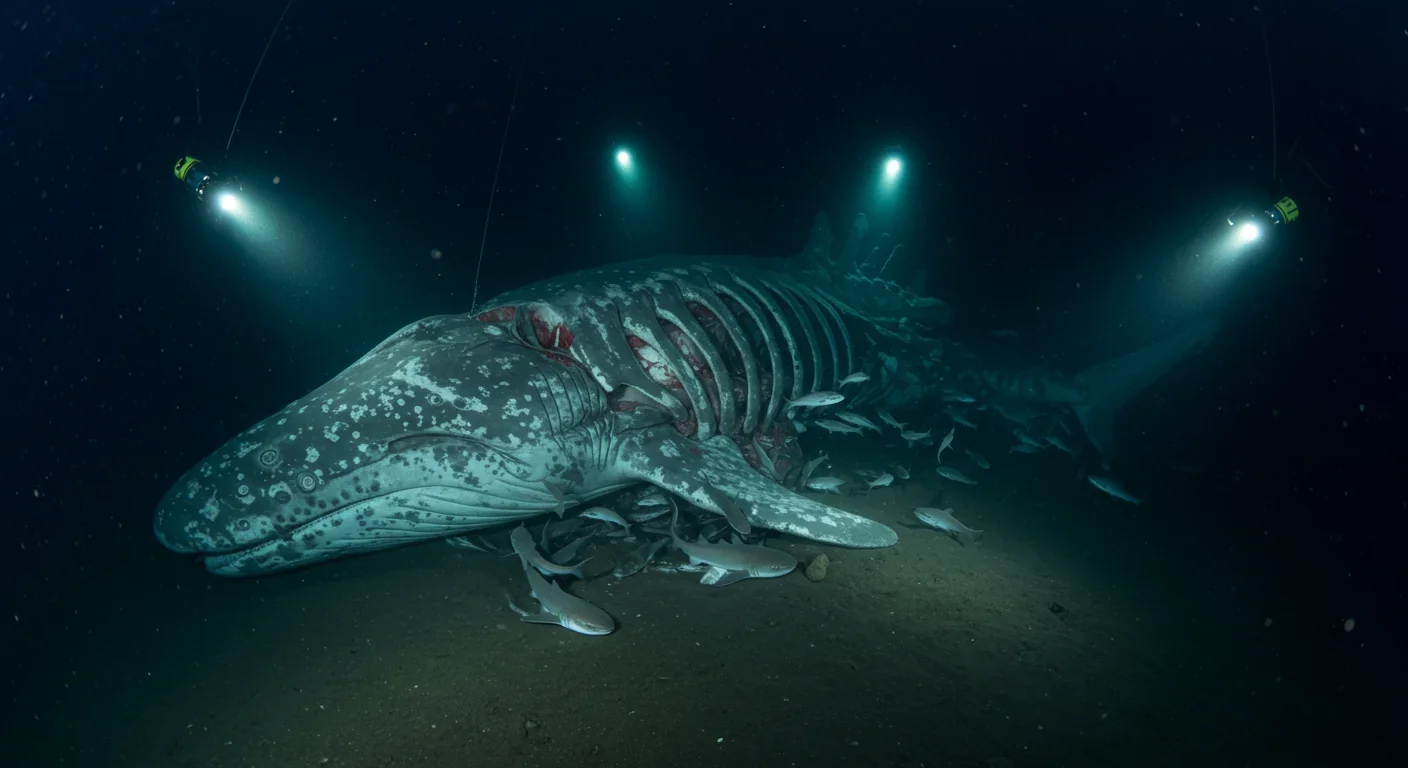
Three miles beneath the ocean's surface, where sunlight never reaches and temperatures hover just above freezing, something extraordinary happens when a whale dies. That single carcass—weighing up to 40 tons—doesn't just disappear into the abyss. Instead, it transforms the barren seafloor into a bustling metropolis teeming with life for 50 to 100 years. Scientists call these phenomenon whale falls, and they represent one of nature's most remarkable recycling systems, sustaining unique communities that exist nowhere else on Earth.
The deep ocean is essentially a desert. Nutrients are scarce, food particles drift down like sparse snowflakes, and creatures eke out existence on a starvation diet. Then a whale fall arrives, delivering a bounty of food equivalent to what small particles would provide over 2,000 years. It's like dropping a fully stocked supermarket into the middle of the Sahara.
When a whale dies and sinks to the seafloor, the race is on. Within hours, the chemical signature of decay spreads through the water, and from miles away, mobile scavengers begin to converge. Sleeper sharks, with their pale, ghostly appearance, arrive first, tearing into the soft tissue with methodical efficiency. Hagfish—primitive eel-like creatures that can tie themselves into knots—burrow directly into the carcass, emerging covered in blubber.
This initial feeding frenzy, known as the mobile scavenger stage, can last anywhere from four months to two years depending on the whale's size and the water temperature. A typical 40-ton gray whale might lose 60 kilograms of tissue per day during this phase. Deep-sea fish swarm the carcass, creating a temporary aggregation of life in an otherwise empty landscape.
The scavengers aren't picky. They consume muscle, blubber, organs, and connective tissue, leaving behind an increasingly bare skeleton. But even as the soft tissue disappears, the ecosystem is just getting started. What looks like the end is actually the beginning of something far more complex.
A single whale fall delivers a nutrient bounty equivalent to 2,000 years of marine snow—transforming the seafloor desert into an oasis of life.
Once the large scavengers have stripped away most of the soft tissue, a different community moves in. Welcome to the enrichment-opportunist stage, where smaller invertebrates take over. This phase typically lasts about two years, though it can extend longer in colder waters.
Polychaete worms—segmented marine worms with bristles along their bodies—colonize the sediment surrounding the carcass, feeding on the organic-rich material that has settled around the bones. Research shows these communities can reach extraordinary densities, with up to 4,183 individuals per square foot. That's more crowded than a rush-hour subway car.
Crustaceans scuttle across the remaining blubber, while mollusks burrow into the nutrient-enriched sediment. The whale skeleton itself becomes prime real estate, providing a rare hard surface in the soft-bottom deep sea. Invertebrate colonies settle on the bones, creating apartment-complex arrangements where different species occupy different sections.
The surrounding area transforms too. The seafloor within a 50-square-meter radius becomes enriched with lipids and organic matter, creating an oasis of fertility. For context, that's about half the size of a tennis court, but in the deep ocean, it might as well be Central Park.
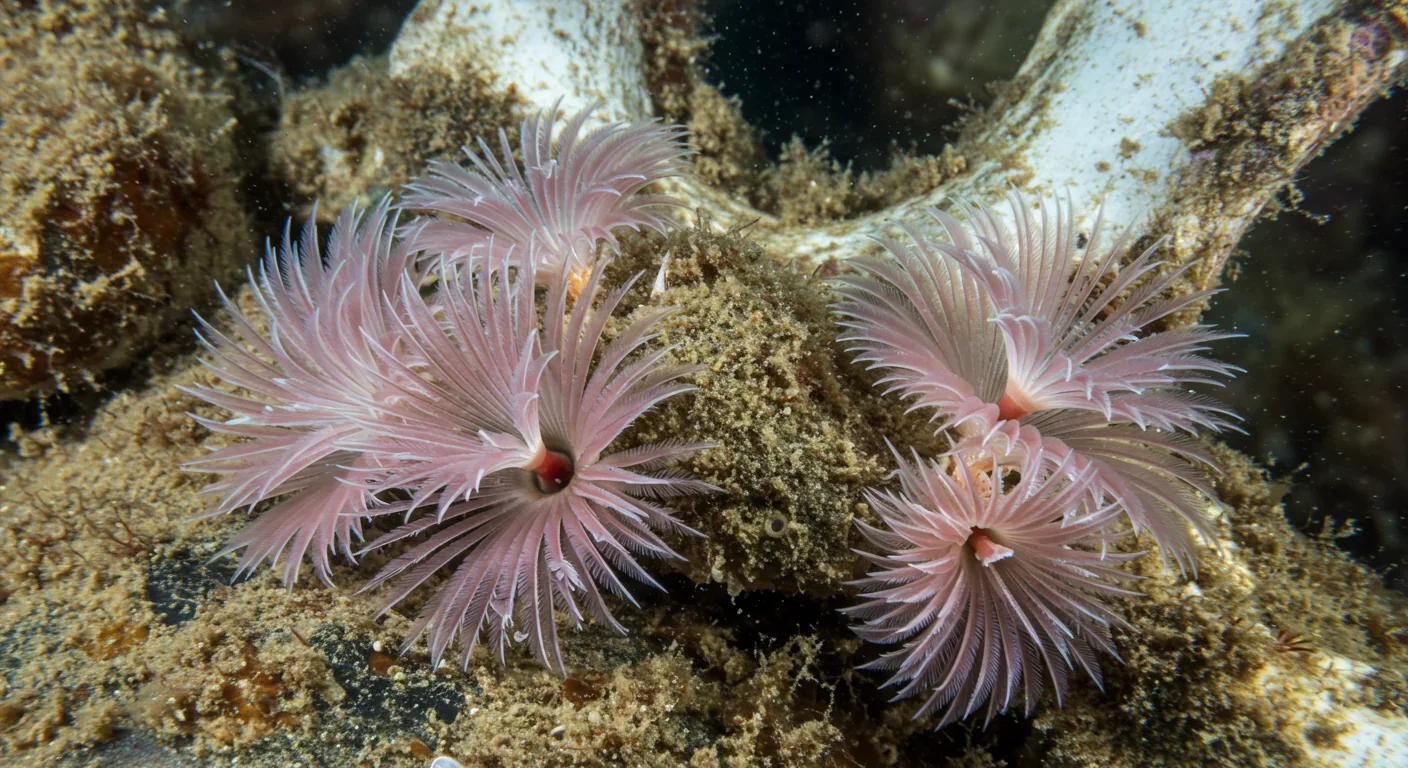
After the opportunists have had their turn, we enter the most fascinating and longest-lasting phase: the sulfophilic stage. This is where things get truly weird.
Whale bones aren't just minerals—they're packed with lipids and fats that remain long after the soft tissue is gone. Specialized anaerobic bacteria colonize the bones and begin breaking down these lipids, releasing hydrogen sulfide as a byproduct. If you've ever smelled rotten eggs, you know hydrogen sulfide. In the deep ocean, it becomes fuel for life.
Enter the bone-eating Osedax worms, bizarre creatures often called "zombie worms." Female Osedax (the males are microscopic and live inside the females) lack mouths and digestive systems. Instead, they send root-like structures deep into whale bones, secreting acid to dissolve the hard material. Inside these roots live symbiotic bacteria that break down the bone lipids and transfer nutrients directly to the worm. It's like having a chemical factory in your basement that feeds you intravenously.
"A whale fall is more than just the end of one life—it is the beginning of countless others."
— Dr. Craig Smith, University of Hawaii
But Osedax aren't alone. Sulfur-oxidizing bacteria form white mats across the bones, consuming the hydrogen sulfide and producing energy through chemosynthesis—the deep-sea equivalent of photosynthesis, but using chemicals instead of light. This process mirrors what happens at hydrothermal vents, those volcanic chimneys on the ocean floor that support entire ecosystems in complete darkness.
The sulfophilic stage can persist for decades. A single large whale can support these communities for 50 to 100 years, providing a stable, long-term habitat in an environment where stability is rare. Some whale falls have been monitored for over 20 years and are still going strong.
Perhaps the most remarkable aspect of whale falls is that they harbor species found nowhere else on Earth. Over 400 species have been documented living on or around whale falls, and many are whale-fall specialists that have evolved specifically to exploit this unusual habitat.
Beyond the Osedax worms, there are specialized snails, clams, and mussels that depend on the chemosynthetic bacteria. Some species of bathymodiolus mussels found on whale falls house their own symbiotic bacteria, creating a double layer of chemosynthetic partnership. The mussels provide a safe home for the bacteria, and the bacteria provide food for the mussels.
Scientists have discovered unique limpets that scrape bacterial films from bones, specialized amphipods that feed on decaying tissue embedded in bone crevices, and bacteria species that exist only in the lipid-rich environment of decomposing whale skeletons. Each whale fall is like an isolated island ecosystem, separated from other falls by miles of empty seafloor, allowing species to evolve in unique directions.
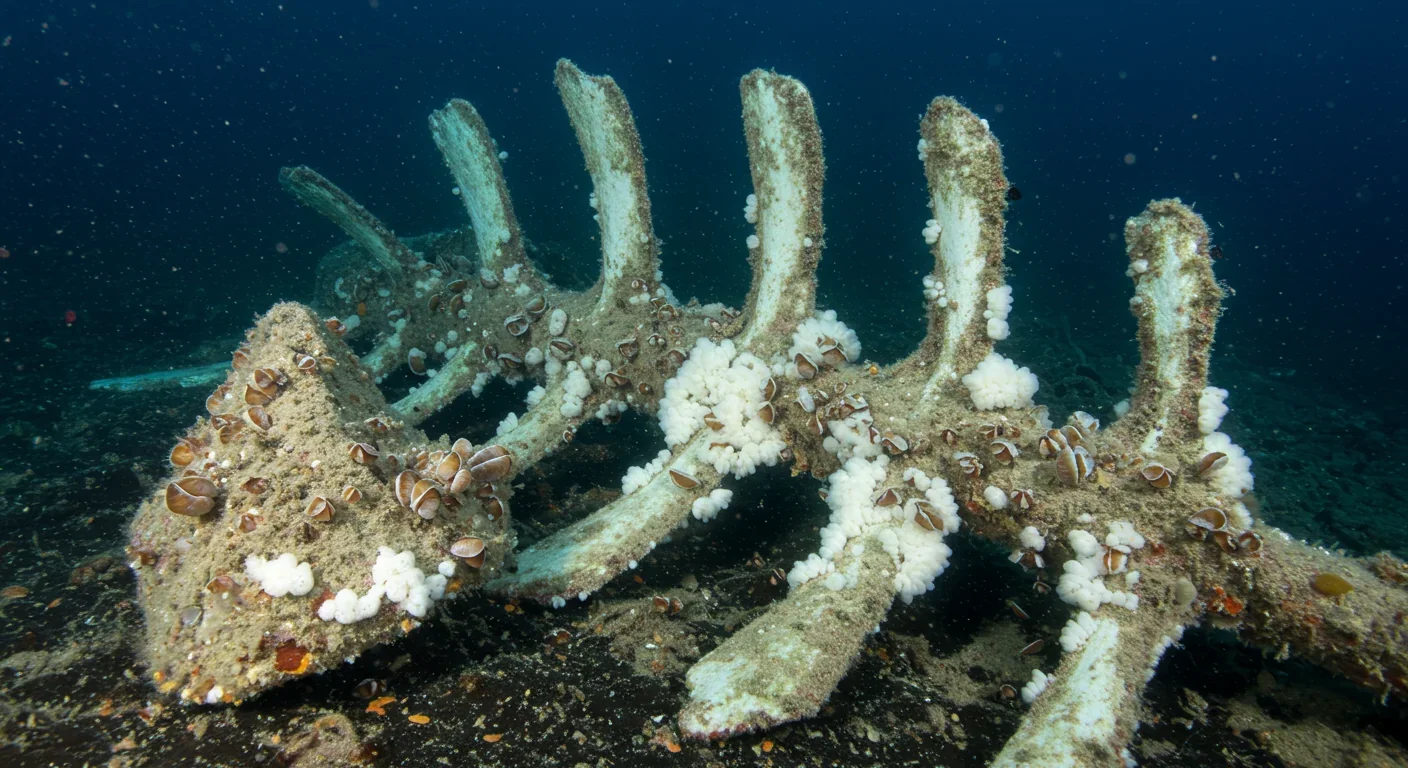
Whale falls serve another crucial ecological function: they act as stepping stones for deep-sea species dispersal. The deep ocean floor is vast and mostly homogeneous, but chemosynthetic communities—places where life is fueled by chemicals rather than sunlight—are scattered like rare oases. These include hydrothermal vents along mid-ocean ridges, cold seeps where methane bubbles from the seafloor, and whale falls.
The problem is that these habitats are separated by sometimes hundreds of miles. How do species adapted to chemosynthetic environments spread from one vent system to another? Scientists believe whale falls provide critical rest stops.
Research indicates that whale falls along migration routes are spaced roughly 12 kilometers apart—close enough for larvae of certain species to drift from one fall to the next on deep ocean currents. This creates biological corridors connecting otherwise isolated ecosystems, allowing genetic exchange and preventing localized extinctions.
The stepping-stone hypothesis helps explain how vent-specialist species can be found across multiple ocean basins despite living in such fragmented habitats. Whale falls may have been the evolutionary bridges that allowed these communities to spread across the planet's deep seafloor over millions of years.
Living whales are magnificent, but dead whales perform a quieter service: they sequester carbon in the deep ocean. When a whale dies and sinks, it takes all the carbon in its body—accumulated over decades of feeding in productive surface waters—and deposits it on the seafloor, effectively locking it away from the atmosphere.
A typical 40-ton whale contains about two tons of carbon. When it sinks to depths below 1,000 meters, that carbon can remain sequestered for centuries or longer, buried in sediments or transformed into bacterial biomass. Current whale falls sequester an estimated 102,000 tons of CO2 to the deep ocean each year.
Whale falls sequester up to 102,000 tons of CO2 annually—a natural carbon transfer mechanism operating for millions of years.
To put this in perspective, that's a tiny fraction of global carbon emissions—between 0.0006% and 0.004% of annual fossil-fuel CO2. But it's not just about the raw numbers. Whale falls represent a natural, self-sustaining carbon transfer mechanism that has operated for millions of years. They're part of what scientists call the biological pump, the suite of processes that move carbon from the atmosphere through the ocean's food web and into the deep sea.
The carbon impact extends beyond just the whale's body. The communities that develop around whale falls incorporate that carbon into their own biomass and the surrounding sediment. Bacteria convert organic carbon into carbonates that precipitate out, essentially turning whale bones into carbon storage units. It's not a climate solution on its own, but it's a reminder of how ocean life contributes to Earth's carbon cycle.
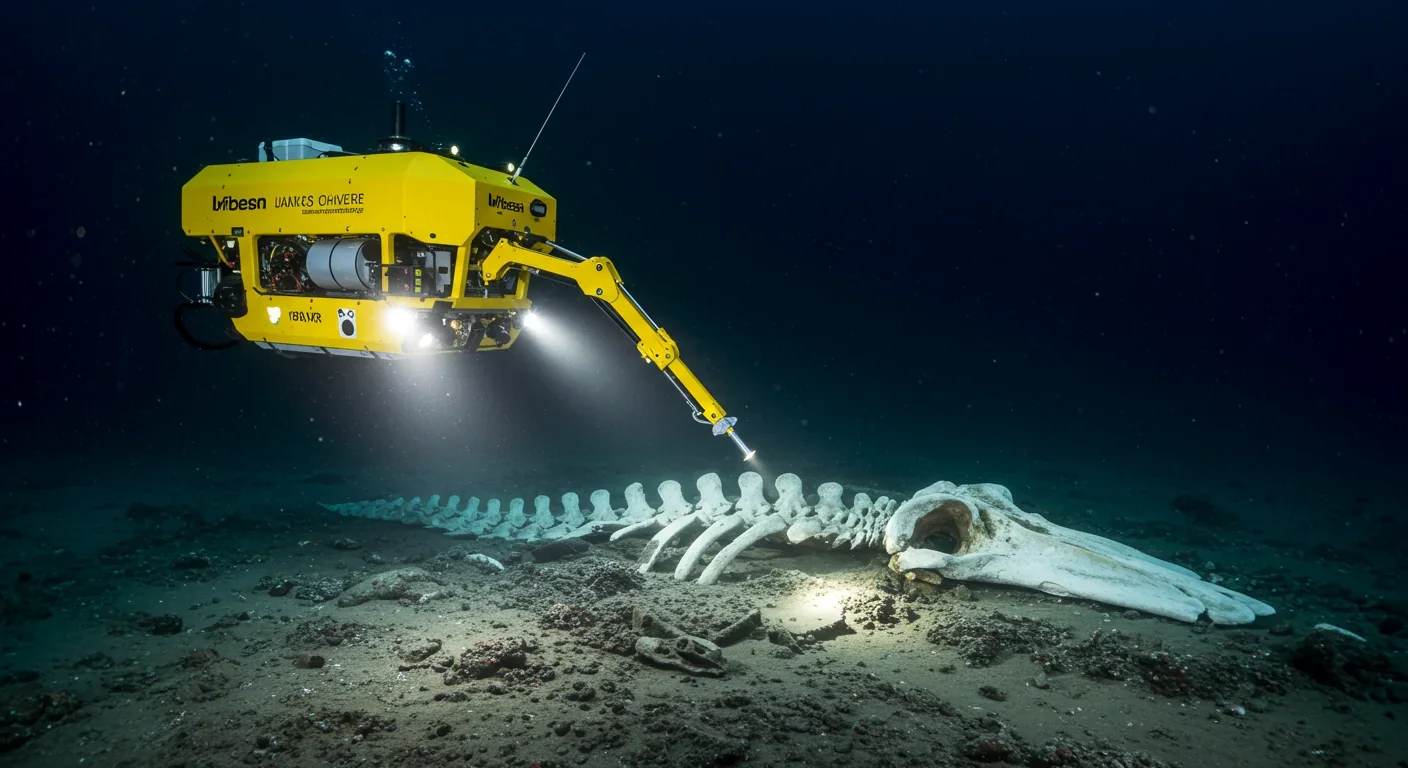
For most of human history, the deep ocean floor received a steady rain of whale falls. Researchers estimate that before industrial whaling, there might have been 690,000 large whale carcasses on the seafloor at any given time, creating a network of deep-sea oases across the world's oceans.
Then came the 20th century. Between 1900 and 1999, commercial whaling removed an estimated 2 to 3 million whales from the oceans. Some populations were reduced by over 90%. Blue whales, the largest animals ever to exist, were hunted to near extinction—from perhaps 350,000 individuals to fewer than 3,000 in some populations.
The impact rippled down to the seafloor. With dramatically fewer whales dying natural deaths, the frequency of whale falls plummeted. Researchers estimate the current rate of whale falls is a fraction of historical levels, potentially reducing deep-sea biodiversity in ways we're only beginning to understand.
Some whale-fall specialist species may have gone extinct before we even discovered them. Others persist in isolated pockets, their populations fragmented and vulnerable. The stepping-stone corridors that once connected chemosynthetic communities across ocean basins may have developed gaps, isolating populations and reducing genetic diversity.
Climate change adds another threat. Expanding oxygen minimum zones—areas where oxygen levels are too low to support most marine life—are encroaching on the depths where whale falls typically occur. As ocean temperatures rise and stratification increases, these low-oxygen areas are growing, potentially making vast regions of seafloor inhospitable to whale-fall communities.
"Expansion of oxygen minimum zones, driven by climate change, is likely to fundamentally alter the diversity of deep-sea whale fall ecosystems."
— Dr. Craig Smith, University of Hawaii
The double impact of historical whaling and ongoing climate change may be fundamentally altering deep-ocean ecosystems in ways that won't be fully apparent for decades.
Whale falls are rare. The deep ocean is vast, dark, and difficult to study. For decades, scientists knew whale falls must exist, but actually finding one was largely a matter of luck. The first natural whale fall wasn't scientifically documented until 1987, when a submersible stumbled upon one by accident.
Since then, technology has improved dramatically. Modern research vessels use side-scan sonar to map the seafloor, identifying anomalies that might be whale carcasses. This technique has increased detection rates by over 300% since 1977. To date, scientists have documented 45 natural whale falls and studied an additional 38 implanted carcasses—whales that died naturally or were stranded on beaches and were then deliberately sunk by researchers.
In 2019, explorers aboard the E/V Nautilus made a remarkable discovery in Monterey Bay National Marine Sanctuary. While investigating an "octopus garden" 10,000 feet beneath the surface, they stumbled upon an active whale fall that had been on the seafloor for about four months. They live-streamed the entire exploration, allowing audiences around the world to witness the spectacle of hagfish writhing in and out of the carcass, crabs swarming the bones, and the seafloor stained dark with organic matter.
Remote-operated vehicles (ROVs) and submersibles like Alvin allow scientists to return to the same whale falls over many years, documenting the succession process in unprecedented detail. Time-lapse cameras have captured the entire decomposition cycle, from fresh carcass to bare skeleton, revealing patterns that were previously only theoretical.
Some researchers have even created artificial whale falls by deliberately sinking whale carcasses in known locations, allowing them to study the colonization process from day one. These experiments have revealed that different ocean basins host different communities, and that depth, temperature, and oxygen levels all influence which species colonize a fall.
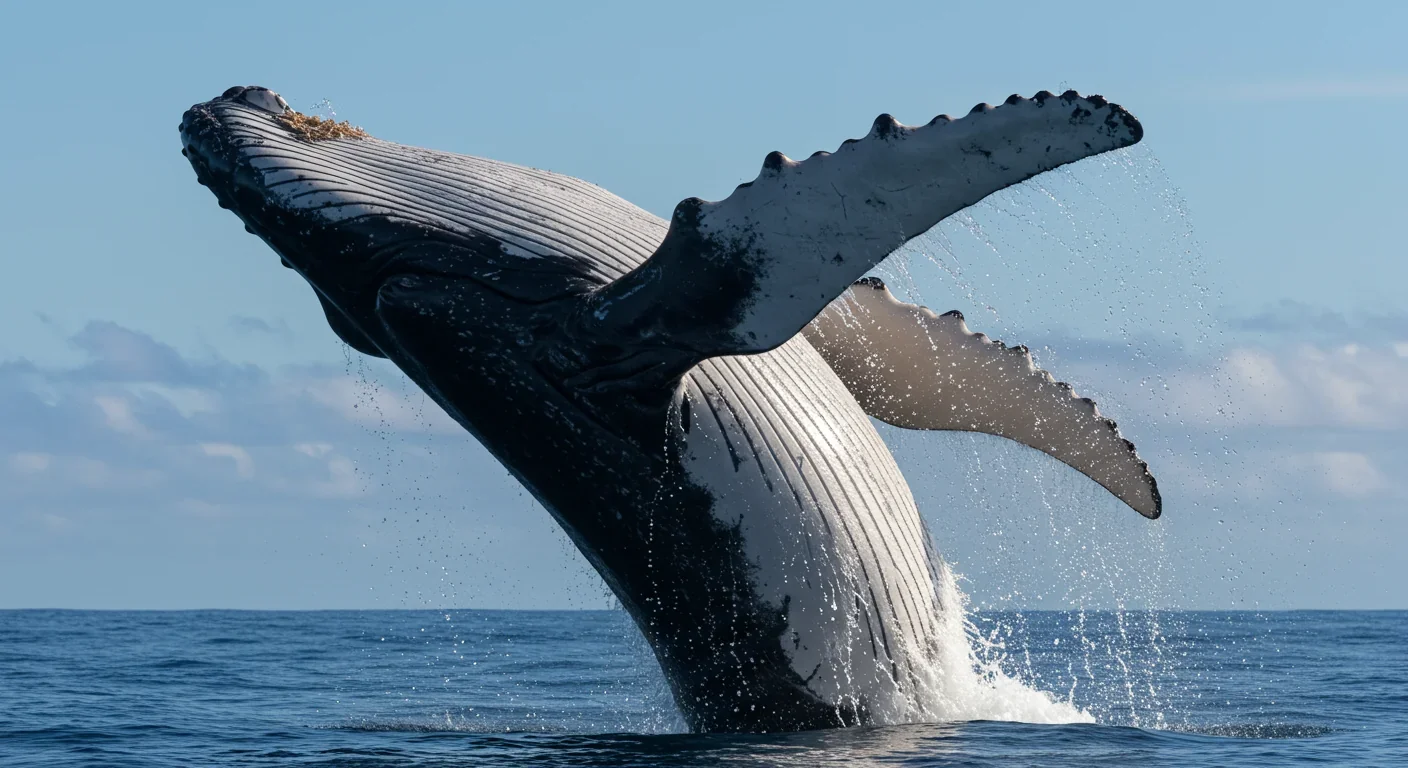
As whale populations slowly recover from the devastation of industrial whaling, there's hope that whale falls may once again become more common on the seafloor. Some species, like humpbacks, have rebounded significantly. Others, like North Atlantic right whales, remain critically endangered, with fewer than 350 individuals remaining.
The recovery is complicated. Whales today face threats their ancestors never encountered: ship strikes, fishing gear entanglement, ocean noise, pollution, and rapidly changing ocean conditions. Even as populations grow, these threats may prevent them from reaching pre-whaling numbers.
But there's something profound about understanding that a whale's contribution to ocean ecosystems doesn't end with its last breath. Every whale that dies and sinks carries with it the potential to create a thriving community, to sequester carbon, to provide stepping stones for rare species, and to sustain life in one of Earth's harshest environments for decades.
Research continues to reveal new aspects of whale-fall ecology. Recent studies have discovered that different whale species—with different bone densities and lipid compositions—create different ecosystem dynamics. Baleen whale falls, for instance, appear to support different communities than toothed whale falls. Scientists are also investigating how whale falls in oxygen minimum zones differ from those in well-oxygenated waters.
Over 400 unique species depend on whale falls, many found nowhere else on Earth—from zombie worms that dissolve bone with acid to bacteria that create energy from hydrogen sulfide.
There's even discussion about deliberately creating artificial whale falls in areas where they've become rare, using beached whales that would otherwise be disposed of. This could help restore some of the stepping-stone corridors that industrial whaling destroyed.
The story of whale falls reminds us that ecosystems are more complex than we imagine, with connections that span from sunlit surface waters to the deepest ocean trenches. A whale spends its life filtering krill in Antarctic waters, migrating thousands of miles, and then in death, creates an island of abundance in the abyssal desert. Creatures that never saw the whale alive depend entirely on its remains.
In many cultures, whales are symbols of majesty and power. Scientists increasingly recognize them as ecosystem engineers—species whose presence fundamentally shapes their environment. But whale-fall ecology adds another dimension: whales engineer ecosystems in death as powerfully as in life.
The sulfophilic communities feeding on a whale skeleton today might persist for another 50 years, long after anyone who saw the living whale has forgotten it. Bacteria converting bone lipids into energy today perpetuate a process that has operated for 30 million years, since whales first evolved from land mammals and returned to the sea.
As we work to protect whales from modern threats, we're not just protecting charismatic megafauna or preserving biodiversity. We're protecting a fundamental ecological process that sustains life in the largest and least understood habitat on Earth. Every whale that lives to old age and dies a natural death is a gift to the deep ocean, a feast that echoes through the abyssal darkness for a century.
The next time you see a whale breach the surface, remember: that individual's contribution to ocean life won't end when its heart stops beating. It will continue for decades, feeding hundreds of species, storing carbon, and creating connections across the seafloor. In the deep ocean, when giants fall, life rises.

MOND proposes gravity changes at low accelerations, explaining galaxy rotation without dark matter. While it predicts thousands of galaxies correctly, it struggles with clusters and cosmology, keeping the dark matter debate alive.

Ultrafine pollution particles smaller than 100 nanometers can bypass the blood-brain barrier through the olfactory nerve and bloodstream, depositing in brain tissue where they trigger neuroinflammation linked to dementia and neurological disorders, yet remain completely unregulated by current air quality standards.

CAES stores excess renewable energy by compressing air in underground caverns, then releases it through turbines during peak demand. New advanced adiabatic systems achieve 70%+ efficiency, making this decades-old technology suddenly competitive for long-duration grid storage.

Our brains are hardwired to see patterns in randomness, causing the gambler's fallacy—the mistaken belief that past random events influence future probabilities. This cognitive bias costs people millions in casinos, investments, and daily decisions.

Forests operate as synchronized living systems with molecular clocks that coordinate metabolism from individual cells to entire ecosystems, creating rhythmic patterns that affect global carbon cycles and climate feedback loops.

Generation Z is the first cohort to come of age amid a polycrisis - interconnected global failures spanning climate, economy, democracy, and health. This cascading reality is fundamentally reshaping how young people think, plan their lives, and organize for change.

Zero-trust security eliminates implicit network trust by requiring continuous verification of every access request. Organizations are rapidly adopting this architecture to address cloud computing, remote work, and sophisticated threats that rendered perimeter defenses obsolete.